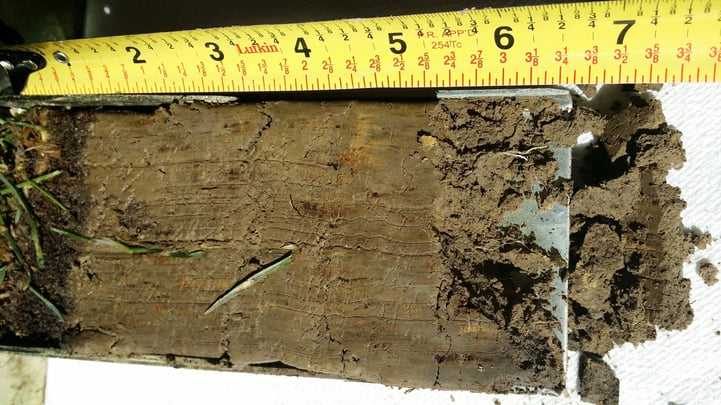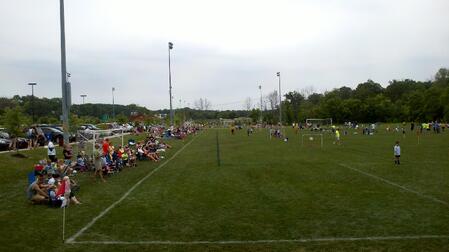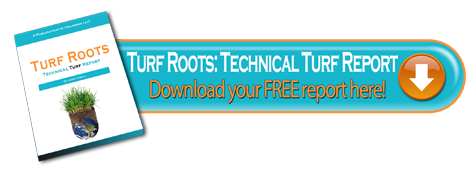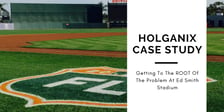By Kaitlyn Ersek on Jun 26, 2014 11:04:00 AM

“It was time to take it to the next step,” says Rebecca Auchter the Sports Turf Manager of Cranberry Township in western Pennsylvania.
Auchter was referring to the turf program designed for Cranberry Township’s three parks, which contain 40 acres of athletic fields (the parks themselves total 300 acres of green space). The newest athletic field, known as the Dicks Sportsplex at Gram Park, contains 18 acres of fully irrigated turf.
Not long after a phased opening in 2008/2009, it was clear to Cranberry Township that they needed a professional to help maintain the quality of turf they have come to expect.
Auchter, an Ohio State Turfgrass Management graduate, had spent the first 15 years of her career in the golf industry before delving into sports turf. She managed the grounds at Ohio Dominican University and then Washington and Jefferson College, so she was well suited for the task of managing Cranberry Township’s fields.
When Auchter joined the Cranberry Township team in 2011, the first thing she did was set a program that included sports turf best practices. Yet, a year later it was easy to see that the Cranberry Township team had taken the field as far as they would go under the current program. It was time to take it to the next level.
Increasing Root Depth and Density
The problem stemmed from the high amounts of traffic, which was putting the turf under major stress. Cranberry Township's athletic fields host over 4,000 events annually. For example, the baseball/softball fields see 200+ games annually. Other problems included the clay-based soils and poor rooting (due to the high traffic and clay soils). “
I knew that I needed to up our game or we weren’t going to keep up with expectations given the traffic and play that Cranberry Township wanted to have on the fields,” reports Auchter.
In early spring of 2013, Auchter was introduced to Holganix Bio 800+ Golf.
“We provided soil and water tests to Holganix scientists and both the ATS and Holganix teams looked over the program closely,” reflects Auchter. One of the major deficiencies was clearly root penetration. “We had trouble getting roots past 2 to 3 inches.”
They applied four applications of Holganix Bio 800+ Golf, totaling 35 ounces of Holganix per 1,000 square feet for the whole year. “We could easily quantify a significant improvement in root depth and the growth of new root hairs.” Auchter was able to find 5+-inch root, even in the center – the most highly trafficked area – of the field.
Reducing inputs with Holganix Bio 800+ Golf
 Another huge difference Holganix was able to affect was the amount of nitrogen needed in order to keep the fields growing and looking their best.
Another huge difference Holganix was able to affect was the amount of nitrogen needed in order to keep the fields growing and looking their best.
In 2012, Auchter used 5.1 lb per 1,000 sq ft of nitrogen on her fields. In 2013, Auchter was able to reduce her use of nitrogen by 28% to 3.8 lb per 1,000 sq ft of nitrogen.
Not only did Auchter report that she had no color or growth issues, but by reducing her nitrogen inputs, Holganix was able to pay for itself.
This year, Auchter is continuing the Holganix program. “We’ll be doing 5 applications this year at 7 oz per 1,000 square feet per app,” says Auchter.
“Holganix Bio 800+ is a huge help in maintaining the health of my highly trafficked turf and that’s where I see the greatest value… I’m looking forward to seeing how the turf does this year with Holganix Bio 800+!”


![Holganix Greater Green Goal [2024 Update]](https://www.holganix.com/hs-fs/hubfs/Blog%20headers%20%232%20%2875%29.jpg?width=224&height=112&name=Blog%20headers%20%232%20%2875%29.jpg)



![Holganix Greater Green Goal [2024 Update]](https://www.holganix.com/hs-fs/hubfs/Blog%20headers%20%232%20%2875%29.jpg?width=120&height=66&name=Blog%20headers%20%232%20%2875%29.jpg)








